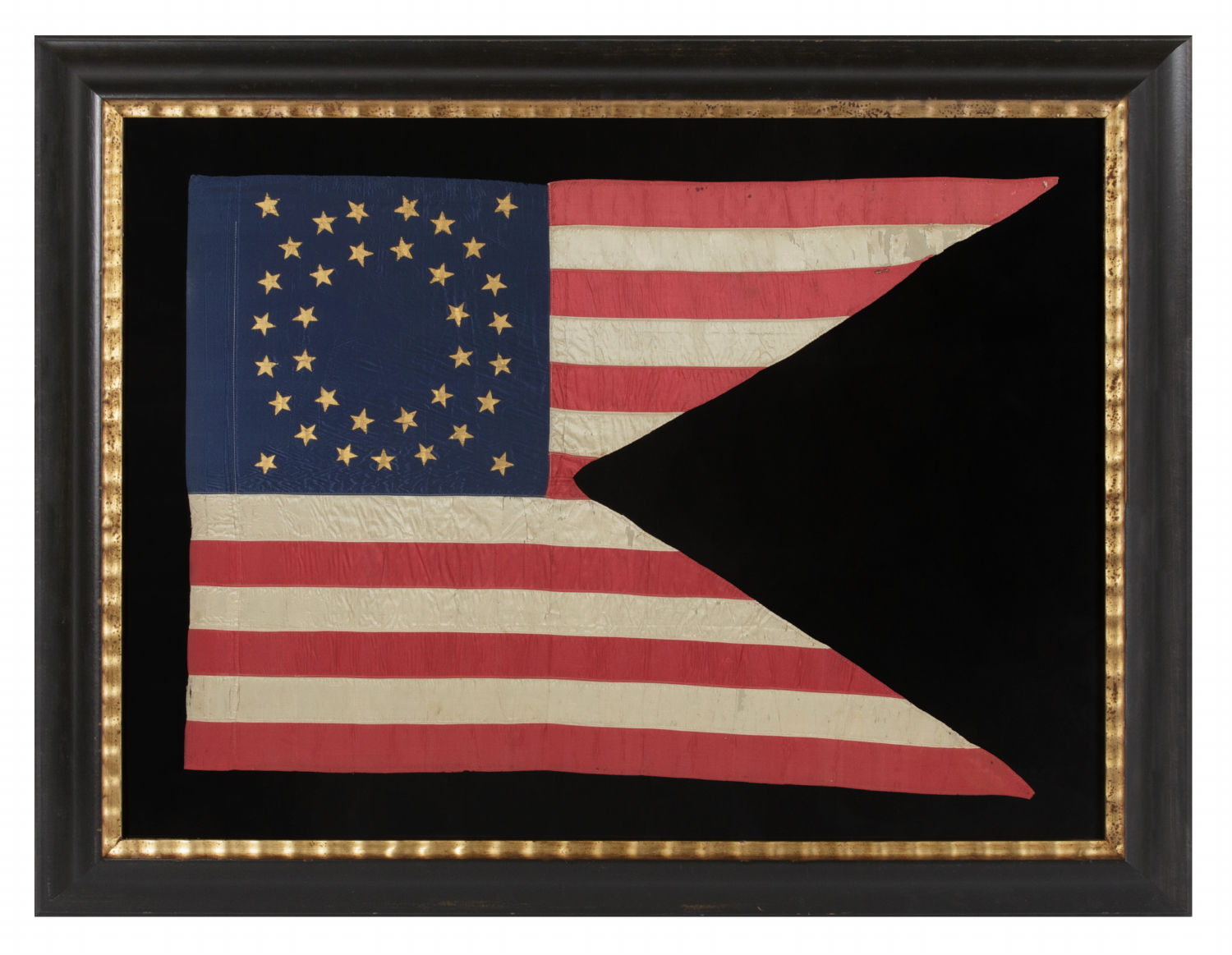
| |
35 STAR SILK CAVALRY GUIDON WITH GILT-PAINTED STARS, IN AN EXCEPTIONAL STATE OF PRESERVATION, CIVIL WAR PERIOD, 1863-65 |
|
| Available: |
Sold |
| Frame Size (H x L): |
42" x 54" |
| Flag Size (H x L): |
29" x 41" |
|
| Description....: |
|
Military issued, Union Army, Civil War battle colors are one of the "Holy Grails" of the flag collecting world. For several reasons, few have survived in private hands. Many were turned back into the state governments from which they were issued, usually at special ceremonies that followed the war. Most were silk, rapidly becoming fragile with age, to say nothing of wear from wartime use. In today's market, surviving flags of this nature wind up being sold as items of significant value because people are much more educated about their worth of these historic objects. Twenty to thirty years ago or more, however, a great flag might easily be discarded if the soldier who possessed it was long deceased, and the brittle silk textile was found in many tiny pieces. Over time, many flags would be donated to various historical societies, museums, state and federal collections, and so as refuse or donation, pass from the hands of personal ownership.
Most of the silk used in the manufacture of Union Army battle flags was treated with agents such as mineral salts, to make the fabric heavier for merchants who sold it by the pound. For this reason, despite how often they were actually carried into battle, even those among the holdings of various armories and museums are typically in deplorable condition. The fact that these were often neglected, due to ignorance about proper care, military code (some could not be unfurled after their placement in special sleeves and cases), or budgetary restrictions, most slipped into a state of disrepair not easily managed by an average person, and with the costs of professional conservation beyond the reach of those with average means.
Like most of its counterparts, this Civil War period military guidon is made entirely of silk with gilt-painted stars. Unlike most, however, it survives in a remarkably fine state of preservation. The profile of this classic cavalry form has a severe swallowtail to accommodate for speed on horseback and the windy conditions involved. The stars are arranged in a double-wreath form of a medallion configuration, with a flanking star outside the pattern in each corner of the blue canton.
Primarily carried by Union cavalry, though sometimes issued to artillery and infantry units when demand outweighed supply, these flags served as flank-markers and allowed an officer to keep sight of his unit. This was especially critical when multiple companies were engaged. Loved by both Civil War and flag collectors alike, few can deny the attraction of their unique and striking presentation.
Another reason for the desirability of Civil War guidons is their small size. At approximately 29 x 40 inches, this is one of the smallest types of flags with pieced-and-sewn construction that was made made prior to the 1890’s. In early America, such flags were typically eight feet long and larger. This is because they were important in their function as signals, meaning that they needed to be seen and recognized from great distance. A flag that was six feet in length was considered small and production of flags smaller than this was extremely limited. Even infantry battle flags were approximately six by six-and-one-half feet and thus practically the size of an average quilt of the same period. Many collectors prefer smaller flags because they are more practical to frame and display.
West Virginia was admitted into the Union as the 35th state on June 20th, 1863, and the 35 star flag was used during the closing years of the Civil War. Although 35 was the official star count until July 4th, 1865, most flag makers would have added a 36th star after the addition of Nevada on October 31st, 1864. Even the military paid little heed to official star counts and would have followed suit, but government orders for 35 star swallowtail guidons were adequate enough that they were not produced in the 36 star count. Some were issued after 1865 and saw use in the Indian Wars.
Construction: Made of plain weave silk with the stars stenciled in gold gilt. The canton and stripes of the flag are pieced and joined with treadle stitching, typical of 35 star swallowtail guidons. The sleeve was created by folding back a section of the stripes and canton, which was bound so that a staff would slip directly through this open portion of the hoist.
Mounting: This is a pressure mount between 100% cotton twill, black in color, and U.V. protective acrylic. The black fabric was washed to reduce excess dye. An acid-free agent was added to the wash to further set the dye and the fabric was heat-treated for the same purpose. The mount was placed in a black-painted, hand-gilded and distressed Italian molding with a wide serpentine (ogee) profile and a rippled inner edge.
Condition: Please inquire for a detailed description. |
|
|
|
| Collector Level: |
Flags for the truest Patriots. My best offerings |
|
| Flag Type: |
Sewn flag |
|
| Star Count: |
35 |
|
| Earliest Date of Origin: |
1861 |
|
| Latest Date of Origin: |
1865 |
|
| State/Affiliation: |
West Virginia |
|
| War Association: |
1861-1865 Civil War |
|
| Price: |
SOLD |
|
| |
Views: 3091 |
|
|
|

